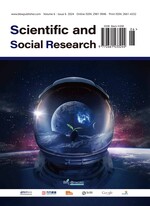Abstract
Cultural exchange has always promoted the development and cooperation of politics, economy, and education among countries. Based on the distribution data of Confucius Institutes in the world from 2004 to 2021, this paper analyzes the evolution of their spatial and temporal pattern by using the methods of kernel density analysis, standard elliptic difference, and spatial autocorrelation. The results show that the distribution of Confucius Institutes in the world has shifted from east to west, showing a trend from Eastern Europe to Africa. After 2008, the distribution of Confucius Institutes has a significant global positive spatial correlation, showing geographical agglomeration. The local spatial correlation analysis shows that the distribution of Confucius Institutes has significant geographical proximity and is affected by the change in the international situation.
References
Wang WJ, 2019, Cultural Exchange and National Image Construction: Taking Sino-US Cultural Exchange as an Example. Journalism Research Guide, 10(2): 108–110.
Kluver R, 2014, The Sage as Strategy: Nodes, Networks, and the Quest for Geopolitical Power in the Confucius Institute. Communication, Culture & Critique, 7(2): 192–209.
An YL, Yu XY, Zeng YP, 2016, The Influence of Language and Culture Promotion Institutions on Cultural Product Trade: A Case Study of Confucius Institutes. International Economic Cooperation, 2016(12): 81–86.
Guo H, 2022, The Impact of Setting Up Confucius Institutes on OFDI of Chinese Enterprises, thesis, Donghua University.
Zheng JJ, 2021, The Appearance of Civilization Diversity and the Realization of Cultural Exchange: Focusing on Confucius Institute. Changbai Tribune, 2021(06): 138–144.
Li Q, Han Y, Li Z, et al., 2021, The Influence of Cultural Exchange on International Trade: An Empirical Test of Confucius Institutes based on China and the Belt and Road Areas. Economic Research, 34(1): 1033–1059.
Lien D, Yao F, Zhang F, 2017, Confucius Institute’s Effects on International Travel to China: Do Cultural Difference or Institutional Quality Matter? Applied Economics, 49(36): 3669–3683.
Zhou Y, Luk S, 2016, Establishing Confucius Institutes: A Tool for Promoting China’s Soft Power? Journal of Contemporary China, 25(100): 628–642.
Ma HZ, Zhong YX, 2020, Spatial and Temporal Distribution Pattern and Influencing Factors of Confucius Institutes. Research on Financial Education, 33(05): 73–80.
Li J, Diao XW, 2021, Preliminary Discussion on the Spatio-Temporal Distribution of Confucius Institutes. China Ethnic Expo, 199(03): 84–86.
Zeng Z, Yang HJ, 2017, Distribution and Influencing Factors of Confucius Institutes in Southeast Asia. Journal of Yunnan Normal University (Teaching and Research Edition of Chinese as a Foreign Language), 15(03): 63–71.
Zou CF, 2021, Does Confucius Institute Promote China’s Foreign Direct Investment in Countries along the Belt and Road. China Storage and Transportation, 248(05): 156–158.
Yu LJ, Huang FJ, Zhu SL, et al., 2019, Spatial Distribution and Influencing Factors of Confucius Institutes in Countries along the Belt and Road. China Economic and Trade Guide (Middle), 948(10): 151–153.
Zhang H, Cao G, Hu L, 2019, Spatial Patterns and Driving Forces of Urban Land Expansion in a Rapidly Urbanizing Region: A Case Study of Wuhan Urban Agglomeration, China. Sustainability, 11(13): 3579.
Wu L, Liu Y, Li X, 2019, Spatio-Temporal Patterns and Driving Forces of Urban Land Expansion in a Developing Megacity: A Case Study of Chongqing, China. Sustainability, 11(14): 3806.
Xu Y, Wang Y, 2016, The Effects of the Confucius Institute on China’s OFDI. International Business, 2016(2): 58–68.
Chen Y, Sun Q, Zhang X, 2017, Will Confucius Institute Promote Outward Foreign Direct Investment? Based on the Panel Data of the Countries along “The Belt and Road”. Journal of International Trade, 2017(8): 84–95.
Yin JJ, Liu ML, Liu WZ, 2023, Spatio-Temporal Heterogeneity of National Geoparks in China and its Influencing Factors. Journal of Natural Sciences of Hunan Normal University, 46(04): 57–69.
Tobler W, 1970, A Computer Movie Simulating Urban Growth in the Detroit Region. Economic Geography, 46(2): 234–240.
Zheng ZP, 2015, Spatial Effects of China’s Regional Foreign Direct Investment: An Analysis based on Spatial Econometric Panel Data. Exploration of Economic Issues, 2015(7): 107–113.
